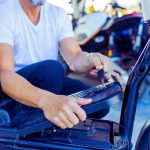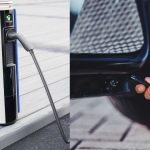Electric scooters are a convenient and environmentally friendly way to get around, but what if your scooter runs out of battery and you don’t have the charger with you? Don’t worry, there are a few methods you can use to charge your electric scooter without the regular charger.
Can I Charge My Electric Scooter Without The Charger?
Yes, you can charge an electric scooter without the original charger in a few different ways:
- Using a compatible replacement scooter charger
- Using a power bank or external battery pack
- Jump starting from a car battery
- Solar charging (for partial charges)
The key things to consider are the voltage and connector type to ensure compatibility with your scooter model. As long as these match the ratings of your scooter battery, you should be able to give it at least some charge to get you by.
Finding A Compatible Replacement Scooter Charger

If you’ve lost or damaged your original electric scooter charger, purchasing a replacement is often the easiest solution for charging without the OEM charger.As long as the voltage matches the scooter’s battery and the connector charges adequately, any third-party scooter charger meeting the basic specifications will work to charge your scooter battery in place of the OEM model. Online retailers like Chargers4Less offer the widest selection of charger replacements for purchase. Here’s what to look for in a compatible replacement charger:
Match The Voltage Rating
- Electric scooters typically use 24V, 36V, 48V or 60V systems. Match the voltage of any replacement to your scooter battery. Using a lower voltage charger than the battery’s rating won’t effectively charge it while using a significantly higher voltage risks damage.
Match The Connector
- The charger connector must mate properly with the charging port on your scooter. Common electric scooter charging connectors include barrel connectors, XLR connectors and custom connectors made specifically for that scooter model. Adapter cables can sometimes be used if you can’t find an exact replacement match.
Check Charging Rate
- Faster 1.5A-2A chargers will charge your scooter battery more quickly than slower 0.5A-1A units. But slower units are often more affordable and still get the job done.
As long as the voltage and connector match, any replacement scooter battery charger meeting the basic specifications to charge your battery can work in place of the OEM charger. Shopping online gives you the widest selection of replacement charging options to choose from.
Using A Power Bank To Charge An Electric Scooter

Portable power banks designed for charging phones and tablets can also charge electric scooter batteries in some situations. The key specification to look for is watt hours (Wh). To effectively charge your scooter battery, the power bank needs sufficient capacity in watt hours. While power bank charging is typically slower and mainly good for partial top-ups, it can help you get home or reach a dedicated charger in a pinch with a depleted scooter battery when no better options exist. Models like the Anker 737 Power Bank offer some of the highest charge capacities ideal for charging electric scooter batteries.
Also Read: How To Fix an Electric Scooter Battery?
Calculating Required Power Bank Capacity
You’ll need to match or exceed your scooter battery’s watt hours. Calculate your scooter’s battery watt hour rating using this simple formula:
Battery Voltage x Battery Capacity in amp hours (Ah) = Watt hours (Wh)
For example, a common 48V 10Ah scooter battery would be:
48V x 10Ah = 480 Wh
So in this case, you’d want a power bank rated for 480 Wh or higher to effectively charge the scooter battery.
Common power bank capacities range from around 20Wh for smaller units up to 300-400Wh for high capacity models. So power banks can usually deliver at least a partial charge, helping you get to your destination when no other charger is available. But fully recharging a depleted scooter battery may require multiple cycles with typical power bank capacities.
Using The Correct Output Voltage
In addition to sufficient watt hour ratings, the power bank output voltage needs to match rating of the scooter battery you’re attempting to charge:
- 24V scooter batteries – Use a 20-25V power bank output
- 36V scooter batteries – Use a 29-37V power bank output
- 48V scooter batteries – Use a 45-50V power bank output
So match the voltage in addition to calculating the needed watt hour rating when selecting a power bank for your electric scooter charging needs.
Jump Starting An Electric Scooter From A Car Battery
Use extreme caution when jump starting scooters, carefully following all safety protocols to avoid damage or injury. In an emergency, electric scooters can be jump started using a car or truck battery and jumper cables. Just like jump starting a car, this provides direct electrical input to recharge a depleted scooter battery.
Jumper cables connect the disabled electric scooter battery to the 12V output of an automobile battery. This higher voltage charges the scooter battery.
Jump Starting Safely
- Only attempt jump starting if you know what you’re doing, as incorrect connections can damage electrical systems in both vehicles.
- Refer to your scooter owner’s manual. Some manufacturers advise against using jump starter connections.
- Protect against sparking by making chassis ground connection last. Unhook in reverse order when finished.
- Do not leave vehicles connected for more than 5 minutes during jump start process to avoid potential overcharging.
- End process immediately if battery overheats or you smell burning or see sparks/smoke indicating short circuiting.
While not recommended unless no other option exists, jump cables can provide enough emergency power to partially recharge an electric scooter battery and travel short distances to access a proper charger.
Solar Charging An Electric Scooter Battery

Direct sunlight provides free renewable electricity every day, so solar charging is possible under the right conditions. But relatively small solar panel sizes that can be mounted on a scooter mean solar charging works best as a supplemental battery maintainer, not a primary charging method.
Solar Panel Capacity For Scooters
- Small 10-30 watt panels can mount on seat posts or rear carry platforms of many sit-down style electric scooters.
- Tiny 5-20 watt panels are sometimes used portably with kick scooters.
- Larger 50+ watt marine panels can be used with heavier folding mobility scooters.
Solar Charging Considerations
- Solar charging is quite slow and mainly useful for offsetting gradual self-discharge of batteries parked outdoors rather than actively recharging from low voltage.
- Capacity is highly dependent on sun intensity and panel/scooter orientation.
- Solar charging works best paired with maximum range driving modes which use lower wattages. This allows meager solar input to have more meaningful impact.
- Overnight charging is recommended for full resets of battery capacity after solar trickle charges during day.
While solar charging electric scooters has definite limitations, every bit of renewable energy helps cut costs and battery discharge cycles over time. Supplement overnight plug-in charging with free solar electricity when possible.
Popular Scooter Models Chargeable Without OEM Chargers
Mainstream electric scooter models from leading brands typically accept replacement chargers as long as the voltage and connectors align with their onboard batteries and charging ports. Some examples of popular scooters chargeable without their original chargers include:
- Xiaomi Mi – Uses 42V DC systems compatible with any 42V scooter charger having the required physical connector.
- Segway Ninebot – Many Segway variants use the same 42V batteries and 2-pin charging ports, allowing charger interchangeability.
- Razor E-Series – Razor kick scooters often charge 24V to 36V batteries from generic chargers having suitable IEC 60320 connectors.
- Hiboy S2 / Max – Feature 36V batteries rechargeable by non-OEM 36V chargers with matching charger tips.
So most common electric scooter models can work with replacement chargers as needed as long as voltage and connectors match between charger and scooter battery systems.
Frequently Asked Questions:
Can I use a higher voltage charger instead?
No, you should never use a charger with higher voltage than the scooter’s battery. Significant voltage mismatches risk permanent damage from overheating or short circuiting the electrical systems.
But in a pinch, lower voltage chargers can be used to deliver a partial charge very slowly. For example, charging a 48V scooter battery with a 36V charger wired appropriately. This is only recommended for emergencies and occasional use. The voltage mismatch reduces charging efficiency.
What about using a lower amperage charger?
Yes, you can charge from a lower amperage (A) charger than the OEM model. It will just take proportionally longer to reach full charge. All else being equal regarding connector compatibility, a 2A charger will charge twice as fast as a 1A charger. But the 1A unit will still work over longer time period.
Can I use a scooter charger on other electric vehicles?
It depends. You cannot use an electric scooter charger with e-bikes or mopeds for example unless voltage AND connectors match properly between the charger and vehicle charging inlet. Cross compatibility usually only works with other scooter models using same voltage batteries and connector types. Carefully verify specifications before charging any electric vehicle with non-OEM chargers.
Can I wire aftermarket batteries in parallel/series to charge?
Technically advanced owners might consider custom wiring battery “packs” together using aftermarket batteries not originally included from the factory. But this requires electrical expertise and still requires matching voltages between charger and overall battery architecture. Most owners are best served simply using OEM replacement batteries with in-kind chargers.
Are there charger safety best practices I should follow?
Yes, always follow basic charging safety protocols including:
- No flammable materials nearby during charging sessions.
- Do not overcharge batteries. Remove from charger promptly when full.
- Do not attempt charging extremely hot batteries immediately after ride. Allow components to cool to ambient temperatures first.
- User recommended charge currents and times for battery type as specified by manufacturer.
- Immediately discontinue all charging activities if you see smoke or detect burning smells indicating malfunction.
Following basic charging safety guidelines optimizes safety, battery lifespan and operational readiness for your scooter fleet.





